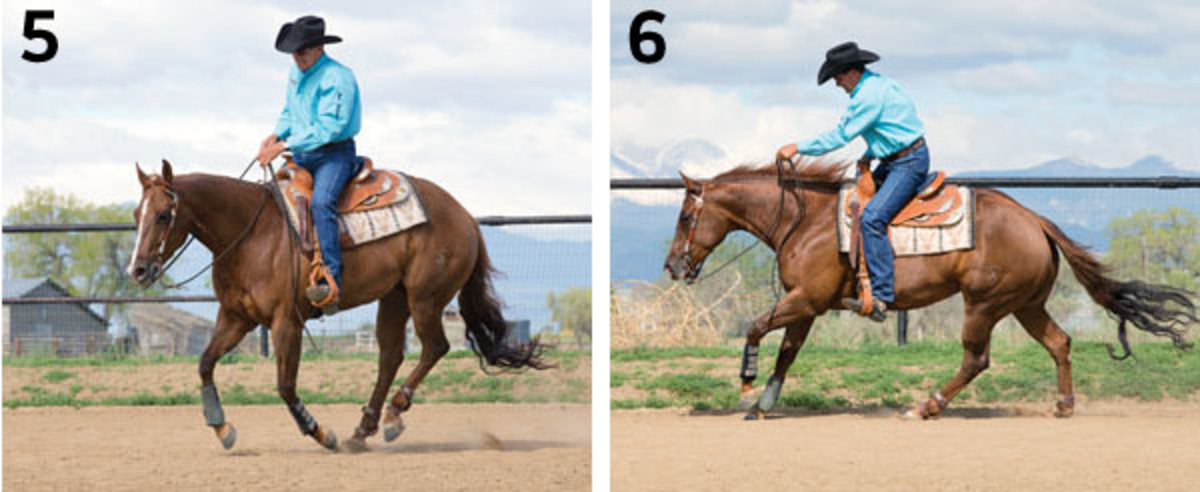When you’re loping with speed and have to make a downward transition to a slower lope, you probably focus on maintaining your horse’s collection, keeping his topline level, and making that transition over a short space of ground. While all of these are important factors for your performance, whether in reining, horsemanship, or ranch pleasure, they don’t hold much weight if your horse breaks gait or falls out of lead during the speed transition.
In reining, a break of gait gets a 2-point penalty, and falling out of lead is at least a 1-point penalty. Similar penalties apply for other classes that call for speed transitions at the lope. Your circles should be the place you strive to mark a zero—meaning no penalties.
Here, I’ll show you what the half-stop transition looks like, where a horse breaks gait and, technically, falls out of lead behind. I’ll then discuss better ways to approach a downward gait change to get your horse cleanly through the transition, without any penalties.
1. I’m loping my horse in a large, fast circle, encouraging her forward motion with my body and my pushed-forward rein hand. She’s loping “between the reins,” meaning she’s looking ahead and her body is aligned behind her, and with good cadence. I’m loping her at a speed I know she can handle—no faster, because that can make for uncollected form and leave the door open for mistakes during downward transitions.

2. Here’s the problem. I’ve asked for a downward transition to a slow lope, but she’s taken the lazy way out. Instead of collecting and slowing her speed, she’s “kicked to the ground,” which means she’s essentially executed a half-halt from the lope, rather than the intended speed transition—a major fault in any pattern that asks for a speed transition, not a stop.
3. This is an extreme example, but my horse has basically stopped and will pick up a slower lope from this stop instead of slowing her fast gait to a slower gait. This results in a 2-point penalty for breaking gait and possibly a 1-point penalty for falling out of lead behind. Not to mention that I’m way out of position in the saddle, and she’s probably discombobulated and will be difficult to put back together to make the rest of the run respectable.
4. To work on this, I collect her front end by picking up my hand. Then I use my outside leg to push her hips toward the center of the circle. This keeps her body engaged, so she’s not lazily loping around the arena, even when she’s traveling with speed. Loping this way is work, so she’ll look for the release and slow her lope when asked, which is what we want—for her to look for the slow-down cues and follow them precisely.
5. I also school her by asking for speed transitions at different points along my circle. Anticipation can be a component of a horse kicking to the ground during a transition. By changing when I cue her to slow down and speed up, I keep her attention on me, because she can’t guess when I’m going to ask her to transition.

6. I’m back working on a large, fast circle, “chasing” my mare up with my forward body position and by keeping my rein hand forward. I use my right leg slightly behind the cinch to keep her left hip in toward the center of the circle to keep her in lead and her body engaged. I use my left leg right around the cinch as further encouragement for her to travel with speed. All of that put together means I’m being a rider, not a passenger.
7. To correctly ask for a downward transition, I release the pressure with my left leg, which I was using to ask for speed, but I keep my right leg in a supportive position on her right side so she doesn’t move her hip out and fall out of lead. I’ve also “stopped riding” with my body—my torso is more upright and I’ve picked up my hand, so I’m not chasing her forward anymore. Additionally, I’ll use my voice, but I won’t say “whoa.” That’d just confuse her and result in a full stop or a half-halt, which gets a penalty. Instead, I hum. Just a low, single note loud enough for her to hear as a slow-down cue.

Steve Schwartzenberger and his wife, Dori, own and operate a breeding and training facility outside Longmont, Colorado. Reining is a family sport, with Steve and Dori training, showing, and judging, and daughters Shevin and Sharee competing in the non-pro. Learn more at ssequine.com.






